Positive Psychology: Wellbeing in School Settings Analysis
VerifiedAdded on 2022/09/07
|16
|4429
|28
Essay
AI Summary
This essay examines the critical topic of psychological wellbeing within school settings, focusing on the student population. It highlights the prevalence of mental health disorders among children and adolescents, emphasizing the significant amount of time spent in schools and the importance of this environment for emotional and social development. The discussion covers various wellbeing considerations, including emotional distress, anxiety, loss of motivation, depression, bullying, stigma, poor self-esteem, loneliness, social isolation, suicide ideation, self-harm, and substance abuse. The essay then introduces Ryff’s Psychological Wellbeing Model, detailing its six components (autonomy, environment mastery, personal growth, positive relationships, purpose in life, and self-acceptance) and how they relate to the challenges faced by students. The rationale for using Ryff's model is explored, along with its limitations, providing a comprehensive overview of the factors impacting student wellbeing and the potential for interventions within the school environment. The essay also provides statistics from Australia on the prevalence of self-harm, suicide and substance abuse, and the impact of these issues on students and families. The assignment emphasizes the importance of addressing mental health concerns in schools and promoting positive psychological wellbeing.
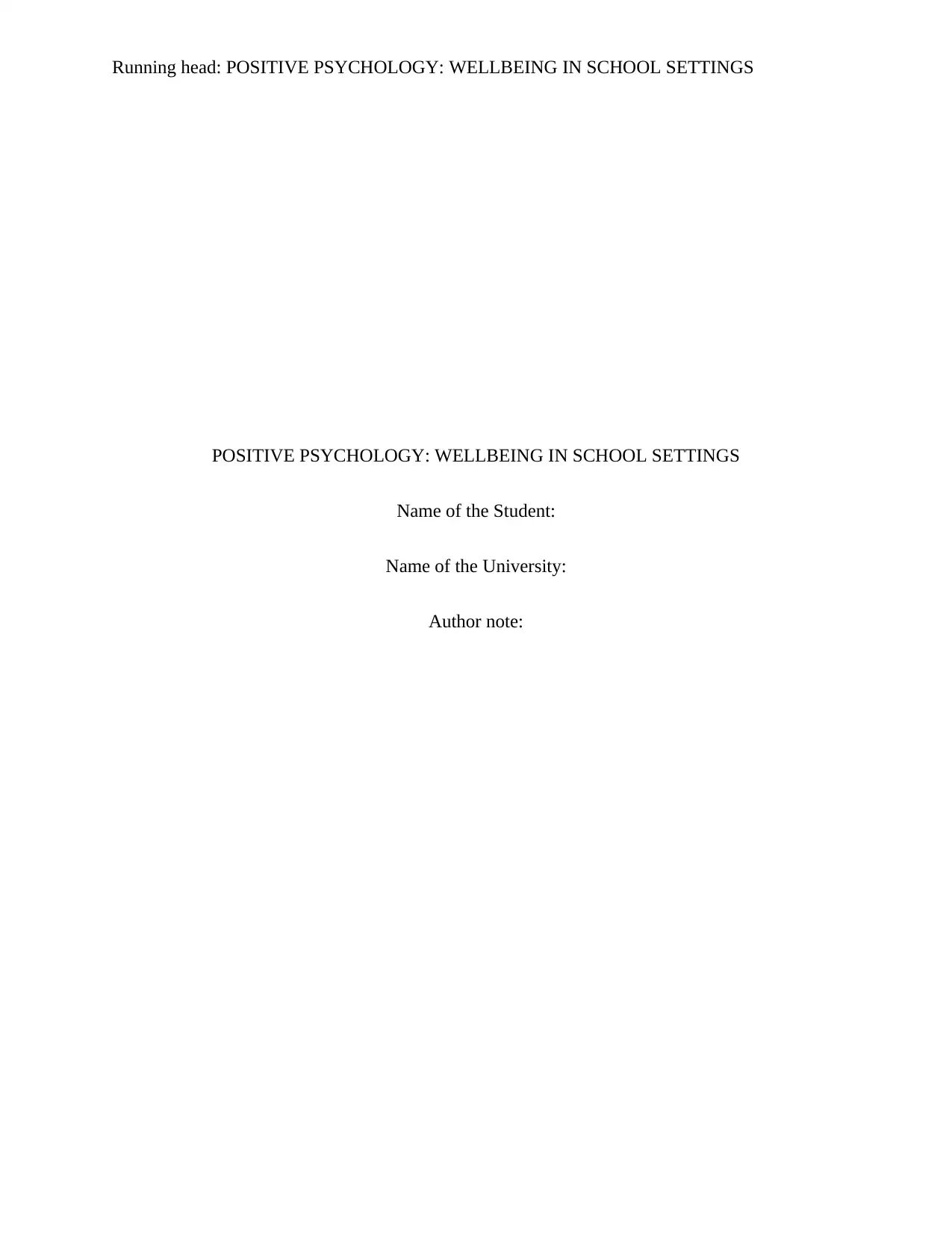
Running head: POSITIVE PSYCHOLOGY: WELLBEING IN SCHOOL SETTINGS
POSITIVE PSYCHOLOGY: WELLBEING IN SCHOOL SETTINGS
Name of the Student:
Name of the University:
Author note:
POSITIVE PSYCHOLOGY: WELLBEING IN SCHOOL SETTINGS
Name of the Student:
Name of the University:
Author note:
Paraphrase This Document
Need a fresh take? Get an instant paraphrase of this document with our AI Paraphraser
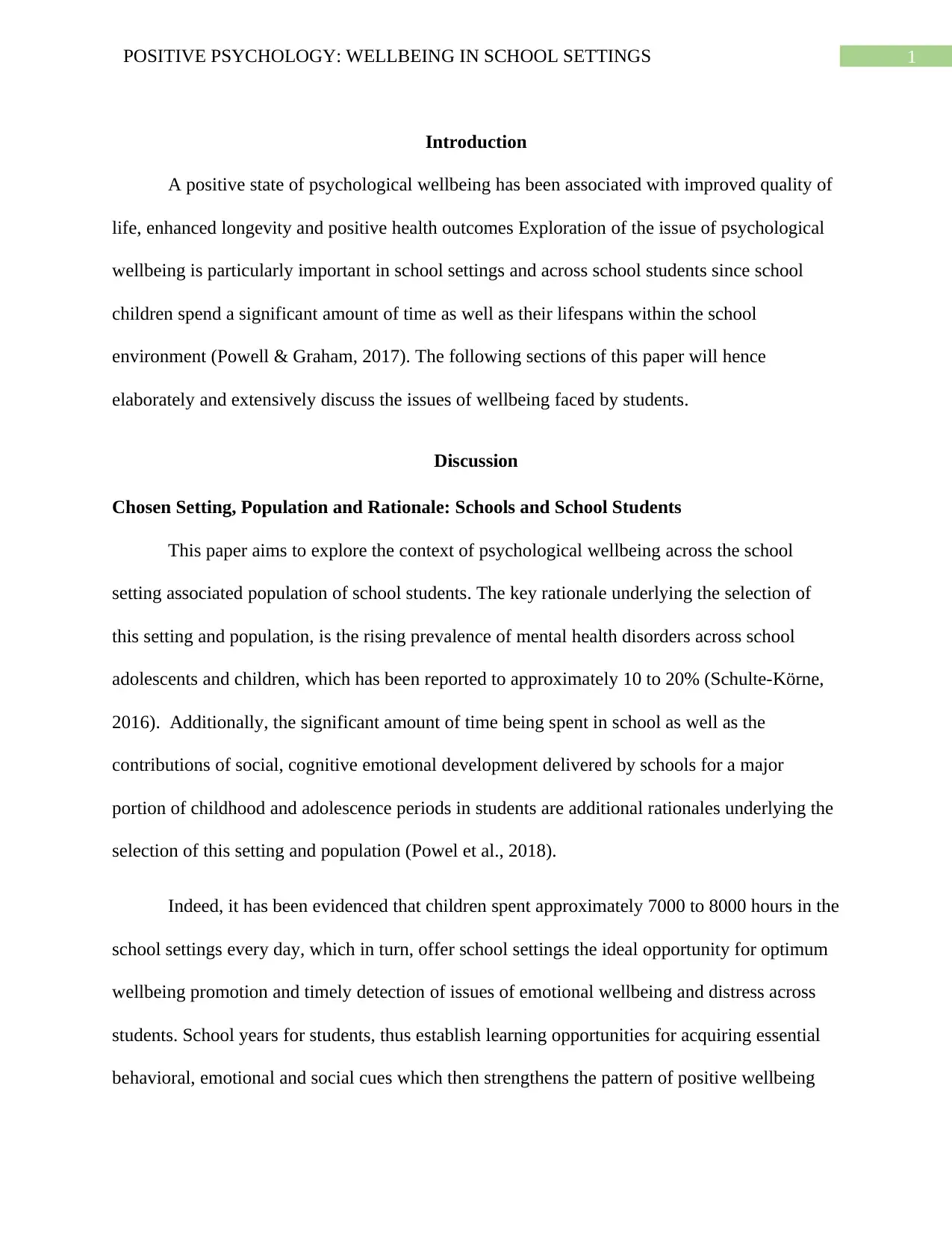
1POSITIVE PSYCHOLOGY: WELLBEING IN SCHOOL SETTINGS
Introduction
A positive state of psychological wellbeing has been associated with improved quality of
life, enhanced longevity and positive health outcomes Exploration of the issue of psychological
wellbeing is particularly important in school settings and across school students since school
children spend a significant amount of time as well as their lifespans within the school
environment (Powell & Graham, 2017). The following sections of this paper will hence
elaborately and extensively discuss the issues of wellbeing faced by students.
Discussion
Chosen Setting, Population and Rationale: Schools and School Students
This paper aims to explore the context of psychological wellbeing across the school
setting associated population of school students. The key rationale underlying the selection of
this setting and population, is the rising prevalence of mental health disorders across school
adolescents and children, which has been reported to approximately 10 to 20% (Schulte-Körne,
2016). Additionally, the significant amount of time being spent in school as well as the
contributions of social, cognitive emotional development delivered by schools for a major
portion of childhood and adolescence periods in students are additional rationales underlying the
selection of this setting and population (Powel et al., 2018).
Indeed, it has been evidenced that children spent approximately 7000 to 8000 hours in the
school settings every day, which in turn, offer school settings the ideal opportunity for optimum
wellbeing promotion and timely detection of issues of emotional wellbeing and distress across
students. School years for students, thus establish learning opportunities for acquiring essential
behavioral, emotional and social cues which then strengthens the pattern of positive wellbeing
Introduction
A positive state of psychological wellbeing has been associated with improved quality of
life, enhanced longevity and positive health outcomes Exploration of the issue of psychological
wellbeing is particularly important in school settings and across school students since school
children spend a significant amount of time as well as their lifespans within the school
environment (Powell & Graham, 2017). The following sections of this paper will hence
elaborately and extensively discuss the issues of wellbeing faced by students.
Discussion
Chosen Setting, Population and Rationale: Schools and School Students
This paper aims to explore the context of psychological wellbeing across the school
setting associated population of school students. The key rationale underlying the selection of
this setting and population, is the rising prevalence of mental health disorders across school
adolescents and children, which has been reported to approximately 10 to 20% (Schulte-Körne,
2016). Additionally, the significant amount of time being spent in school as well as the
contributions of social, cognitive emotional development delivered by schools for a major
portion of childhood and adolescence periods in students are additional rationales underlying the
selection of this setting and population (Powel et al., 2018).
Indeed, it has been evidenced that children spent approximately 7000 to 8000 hours in the
school settings every day, which in turn, offer school settings the ideal opportunity for optimum
wellbeing promotion and timely detection of issues of emotional wellbeing and distress across
students. School years for students, thus establish learning opportunities for acquiring essential
behavioral, emotional and social cues which then strengthens the pattern of positive wellbeing
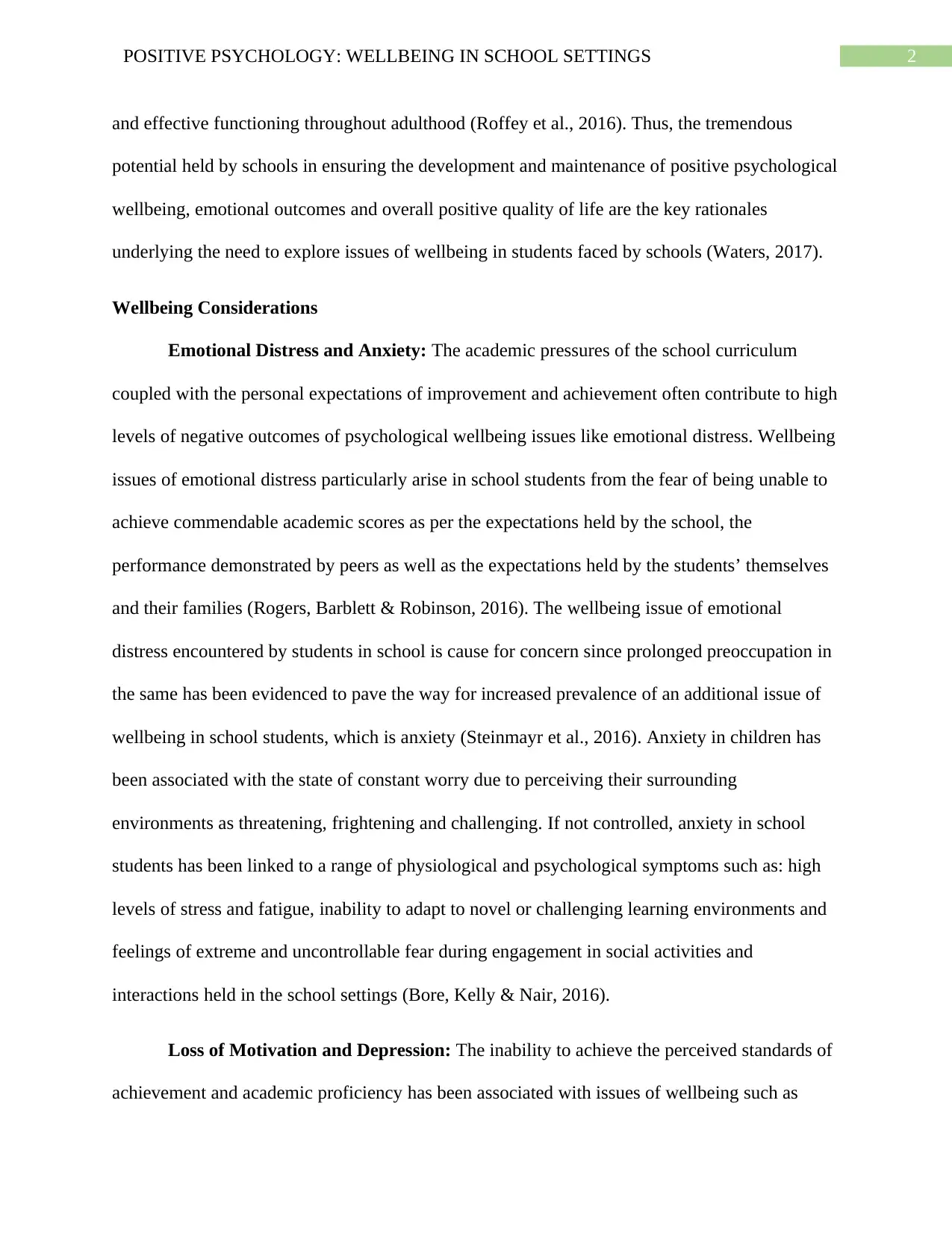
2POSITIVE PSYCHOLOGY: WELLBEING IN SCHOOL SETTINGS
and effective functioning throughout adulthood (Roffey et al., 2016). Thus, the tremendous
potential held by schools in ensuring the development and maintenance of positive psychological
wellbeing, emotional outcomes and overall positive quality of life are the key rationales
underlying the need to explore issues of wellbeing in students faced by schools (Waters, 2017).
Wellbeing Considerations
Emotional Distress and Anxiety: The academic pressures of the school curriculum
coupled with the personal expectations of improvement and achievement often contribute to high
levels of negative outcomes of psychological wellbeing issues like emotional distress. Wellbeing
issues of emotional distress particularly arise in school students from the fear of being unable to
achieve commendable academic scores as per the expectations held by the school, the
performance demonstrated by peers as well as the expectations held by the students’ themselves
and their families (Rogers, Barblett & Robinson, 2016). The wellbeing issue of emotional
distress encountered by students in school is cause for concern since prolonged preoccupation in
the same has been evidenced to pave the way for increased prevalence of an additional issue of
wellbeing in school students, which is anxiety (Steinmayr et al., 2016). Anxiety in children has
been associated with the state of constant worry due to perceiving their surrounding
environments as threatening, frightening and challenging. If not controlled, anxiety in school
students has been linked to a range of physiological and psychological symptoms such as: high
levels of stress and fatigue, inability to adapt to novel or challenging learning environments and
feelings of extreme and uncontrollable fear during engagement in social activities and
interactions held in the school settings (Bore, Kelly & Nair, 2016).
Loss of Motivation and Depression: The inability to achieve the perceived standards of
achievement and academic proficiency has been associated with issues of wellbeing such as
and effective functioning throughout adulthood (Roffey et al., 2016). Thus, the tremendous
potential held by schools in ensuring the development and maintenance of positive psychological
wellbeing, emotional outcomes and overall positive quality of life are the key rationales
underlying the need to explore issues of wellbeing in students faced by schools (Waters, 2017).
Wellbeing Considerations
Emotional Distress and Anxiety: The academic pressures of the school curriculum
coupled with the personal expectations of improvement and achievement often contribute to high
levels of negative outcomes of psychological wellbeing issues like emotional distress. Wellbeing
issues of emotional distress particularly arise in school students from the fear of being unable to
achieve commendable academic scores as per the expectations held by the school, the
performance demonstrated by peers as well as the expectations held by the students’ themselves
and their families (Rogers, Barblett & Robinson, 2016). The wellbeing issue of emotional
distress encountered by students in school is cause for concern since prolonged preoccupation in
the same has been evidenced to pave the way for increased prevalence of an additional issue of
wellbeing in school students, which is anxiety (Steinmayr et al., 2016). Anxiety in children has
been associated with the state of constant worry due to perceiving their surrounding
environments as threatening, frightening and challenging. If not controlled, anxiety in school
students has been linked to a range of physiological and psychological symptoms such as: high
levels of stress and fatigue, inability to adapt to novel or challenging learning environments and
feelings of extreme and uncontrollable fear during engagement in social activities and
interactions held in the school settings (Bore, Kelly & Nair, 2016).
Loss of Motivation and Depression: The inability to achieve the perceived standards of
achievement and academic proficiency has been associated with issues of wellbeing such as
⊘ This is a preview!⊘
Do you want full access?
Subscribe today to unlock all pages.

Trusted by 1+ million students worldwide
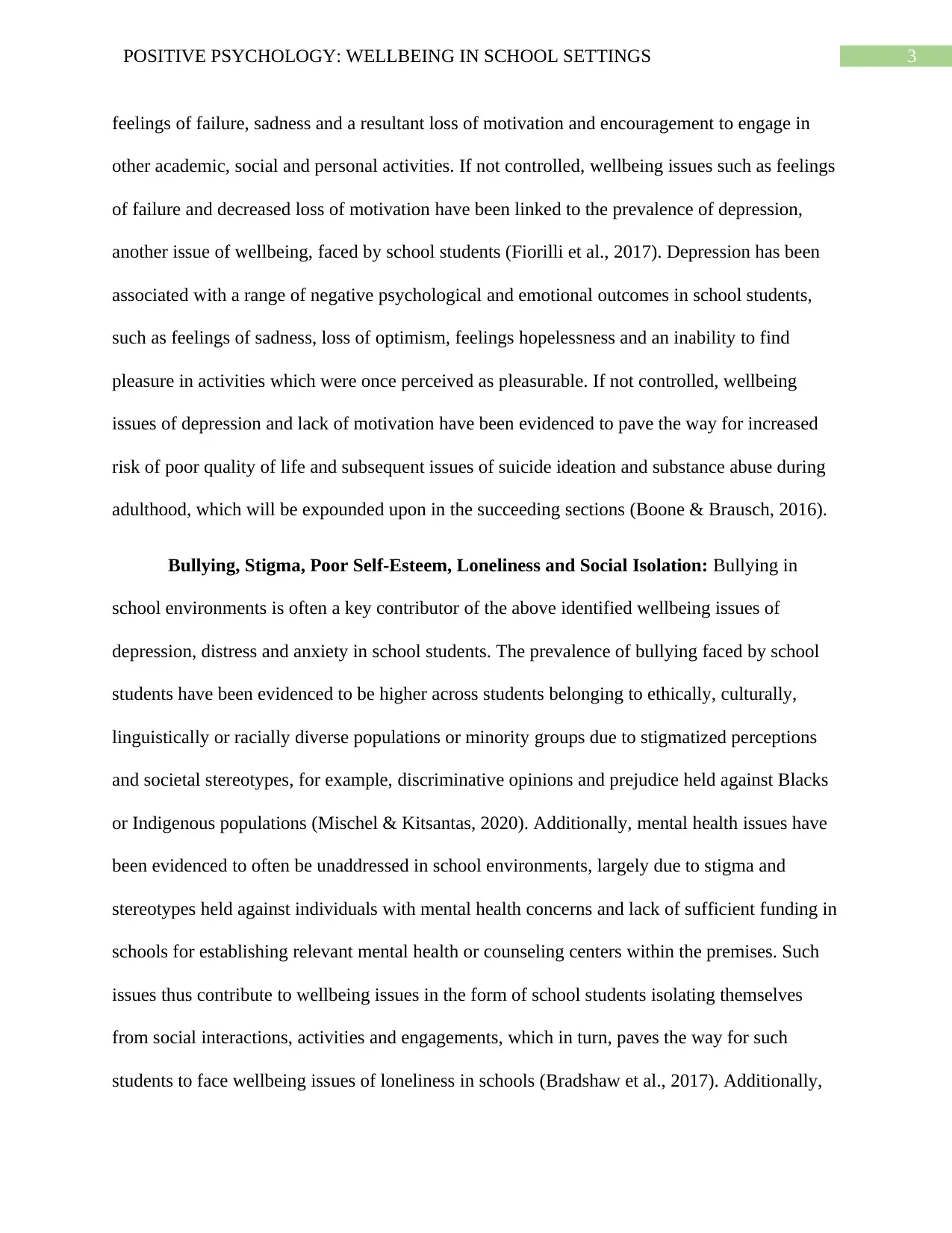
3POSITIVE PSYCHOLOGY: WELLBEING IN SCHOOL SETTINGS
feelings of failure, sadness and a resultant loss of motivation and encouragement to engage in
other academic, social and personal activities. If not controlled, wellbeing issues such as feelings
of failure and decreased loss of motivation have been linked to the prevalence of depression,
another issue of wellbeing, faced by school students (Fiorilli et al., 2017). Depression has been
associated with a range of negative psychological and emotional outcomes in school students,
such as feelings of sadness, loss of optimism, feelings hopelessness and an inability to find
pleasure in activities which were once perceived as pleasurable. If not controlled, wellbeing
issues of depression and lack of motivation have been evidenced to pave the way for increased
risk of poor quality of life and subsequent issues of suicide ideation and substance abuse during
adulthood, which will be expounded upon in the succeeding sections (Boone & Brausch, 2016).
Bullying, Stigma, Poor Self-Esteem, Loneliness and Social Isolation: Bullying in
school environments is often a key contributor of the above identified wellbeing issues of
depression, distress and anxiety in school students. The prevalence of bullying faced by school
students have been evidenced to be higher across students belonging to ethically, culturally,
linguistically or racially diverse populations or minority groups due to stigmatized perceptions
and societal stereotypes, for example, discriminative opinions and prejudice held against Blacks
or Indigenous populations (Mischel & Kitsantas, 2020). Additionally, mental health issues have
been evidenced to often be unaddressed in school environments, largely due to stigma and
stereotypes held against individuals with mental health concerns and lack of sufficient funding in
schools for establishing relevant mental health or counseling centers within the premises. Such
issues thus contribute to wellbeing issues in the form of school students isolating themselves
from social interactions, activities and engagements, which in turn, paves the way for such
students to face wellbeing issues of loneliness in schools (Bradshaw et al., 2017). Additionally,
feelings of failure, sadness and a resultant loss of motivation and encouragement to engage in
other academic, social and personal activities. If not controlled, wellbeing issues such as feelings
of failure and decreased loss of motivation have been linked to the prevalence of depression,
another issue of wellbeing, faced by school students (Fiorilli et al., 2017). Depression has been
associated with a range of negative psychological and emotional outcomes in school students,
such as feelings of sadness, loss of optimism, feelings hopelessness and an inability to find
pleasure in activities which were once perceived as pleasurable. If not controlled, wellbeing
issues of depression and lack of motivation have been evidenced to pave the way for increased
risk of poor quality of life and subsequent issues of suicide ideation and substance abuse during
adulthood, which will be expounded upon in the succeeding sections (Boone & Brausch, 2016).
Bullying, Stigma, Poor Self-Esteem, Loneliness and Social Isolation: Bullying in
school environments is often a key contributor of the above identified wellbeing issues of
depression, distress and anxiety in school students. The prevalence of bullying faced by school
students have been evidenced to be higher across students belonging to ethically, culturally,
linguistically or racially diverse populations or minority groups due to stigmatized perceptions
and societal stereotypes, for example, discriminative opinions and prejudice held against Blacks
or Indigenous populations (Mischel & Kitsantas, 2020). Additionally, mental health issues have
been evidenced to often be unaddressed in school environments, largely due to stigma and
stereotypes held against individuals with mental health concerns and lack of sufficient funding in
schools for establishing relevant mental health or counseling centers within the premises. Such
issues thus contribute to wellbeing issues in the form of school students isolating themselves
from social interactions, activities and engagements, which in turn, paves the way for such
students to face wellbeing issues of loneliness in schools (Bradshaw et al., 2017). Additionally,
Paraphrase This Document
Need a fresh take? Get an instant paraphrase of this document with our AI Paraphraser
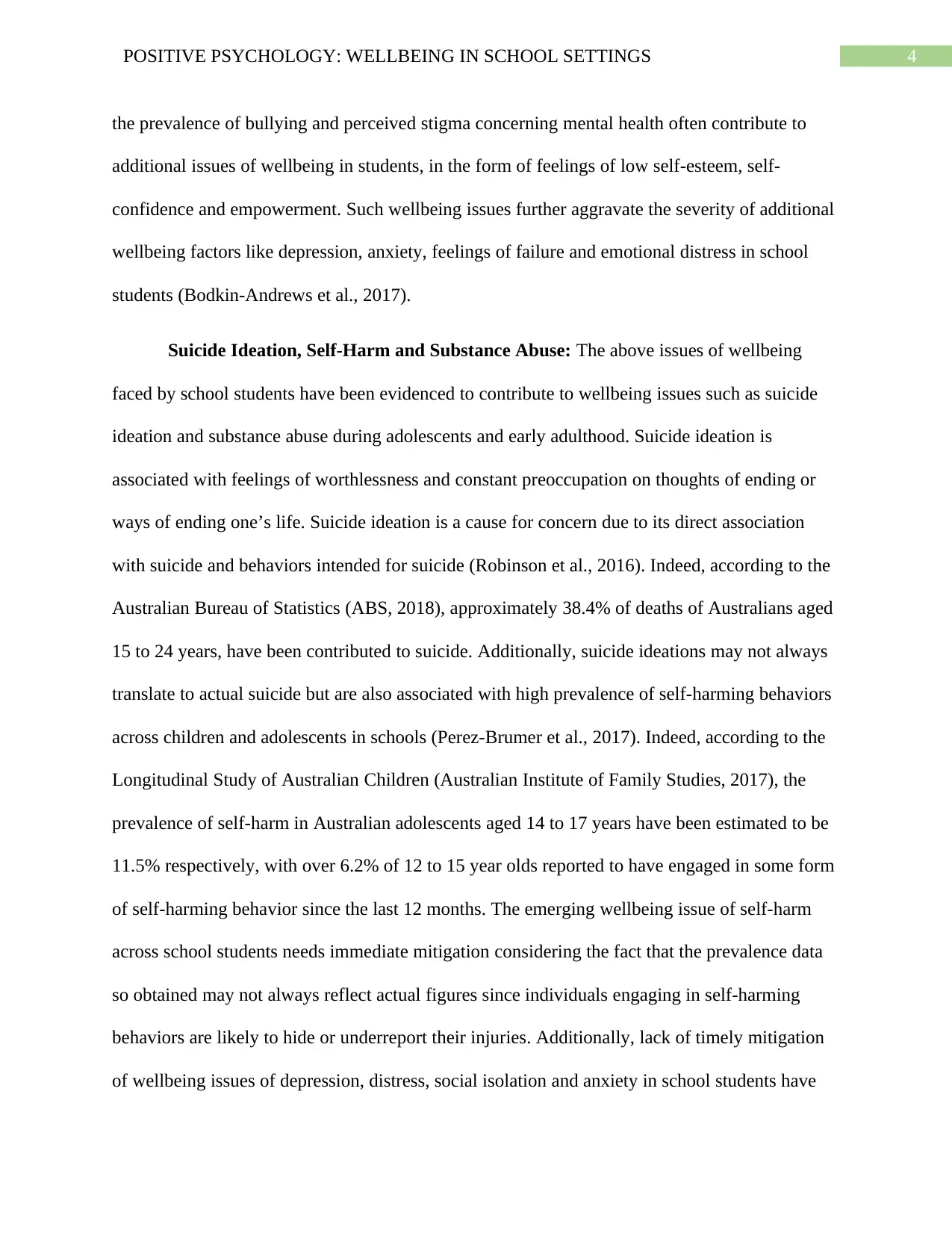
4POSITIVE PSYCHOLOGY: WELLBEING IN SCHOOL SETTINGS
the prevalence of bullying and perceived stigma concerning mental health often contribute to
additional issues of wellbeing in students, in the form of feelings of low self-esteem, self-
confidence and empowerment. Such wellbeing issues further aggravate the severity of additional
wellbeing factors like depression, anxiety, feelings of failure and emotional distress in school
students (Bodkin-Andrews et al., 2017).
Suicide Ideation, Self-Harm and Substance Abuse: The above issues of wellbeing
faced by school students have been evidenced to contribute to wellbeing issues such as suicide
ideation and substance abuse during adolescents and early adulthood. Suicide ideation is
associated with feelings of worthlessness and constant preoccupation on thoughts of ending or
ways of ending one’s life. Suicide ideation is a cause for concern due to its direct association
with suicide and behaviors intended for suicide (Robinson et al., 2016). Indeed, according to the
Australian Bureau of Statistics (ABS, 2018), approximately 38.4% of deaths of Australians aged
15 to 24 years, have been contributed to suicide. Additionally, suicide ideations may not always
translate to actual suicide but are also associated with high prevalence of self-harming behaviors
across children and adolescents in schools (Perez-Brumer et al., 2017). Indeed, according to the
Longitudinal Study of Australian Children (Australian Institute of Family Studies, 2017), the
prevalence of self-harm in Australian adolescents aged 14 to 17 years have been estimated to be
11.5% respectively, with over 6.2% of 12 to 15 year olds reported to have engaged in some form
of self-harming behavior since the last 12 months. The emerging wellbeing issue of self-harm
across school students needs immediate mitigation considering the fact that the prevalence data
so obtained may not always reflect actual figures since individuals engaging in self-harming
behaviors are likely to hide or underreport their injuries. Additionally, lack of timely mitigation
of wellbeing issues of depression, distress, social isolation and anxiety in school students have
the prevalence of bullying and perceived stigma concerning mental health often contribute to
additional issues of wellbeing in students, in the form of feelings of low self-esteem, self-
confidence and empowerment. Such wellbeing issues further aggravate the severity of additional
wellbeing factors like depression, anxiety, feelings of failure and emotional distress in school
students (Bodkin-Andrews et al., 2017).
Suicide Ideation, Self-Harm and Substance Abuse: The above issues of wellbeing
faced by school students have been evidenced to contribute to wellbeing issues such as suicide
ideation and substance abuse during adolescents and early adulthood. Suicide ideation is
associated with feelings of worthlessness and constant preoccupation on thoughts of ending or
ways of ending one’s life. Suicide ideation is a cause for concern due to its direct association
with suicide and behaviors intended for suicide (Robinson et al., 2016). Indeed, according to the
Australian Bureau of Statistics (ABS, 2018), approximately 38.4% of deaths of Australians aged
15 to 24 years, have been contributed to suicide. Additionally, suicide ideations may not always
translate to actual suicide but are also associated with high prevalence of self-harming behaviors
across children and adolescents in schools (Perez-Brumer et al., 2017). Indeed, according to the
Longitudinal Study of Australian Children (Australian Institute of Family Studies, 2017), the
prevalence of self-harm in Australian adolescents aged 14 to 17 years have been estimated to be
11.5% respectively, with over 6.2% of 12 to 15 year olds reported to have engaged in some form
of self-harming behavior since the last 12 months. The emerging wellbeing issue of self-harm
across school students needs immediate mitigation considering the fact that the prevalence data
so obtained may not always reflect actual figures since individuals engaging in self-harming
behaviors are likely to hide or underreport their injuries. Additionally, lack of timely mitigation
of wellbeing issues of depression, distress, social isolation and anxiety in school students have
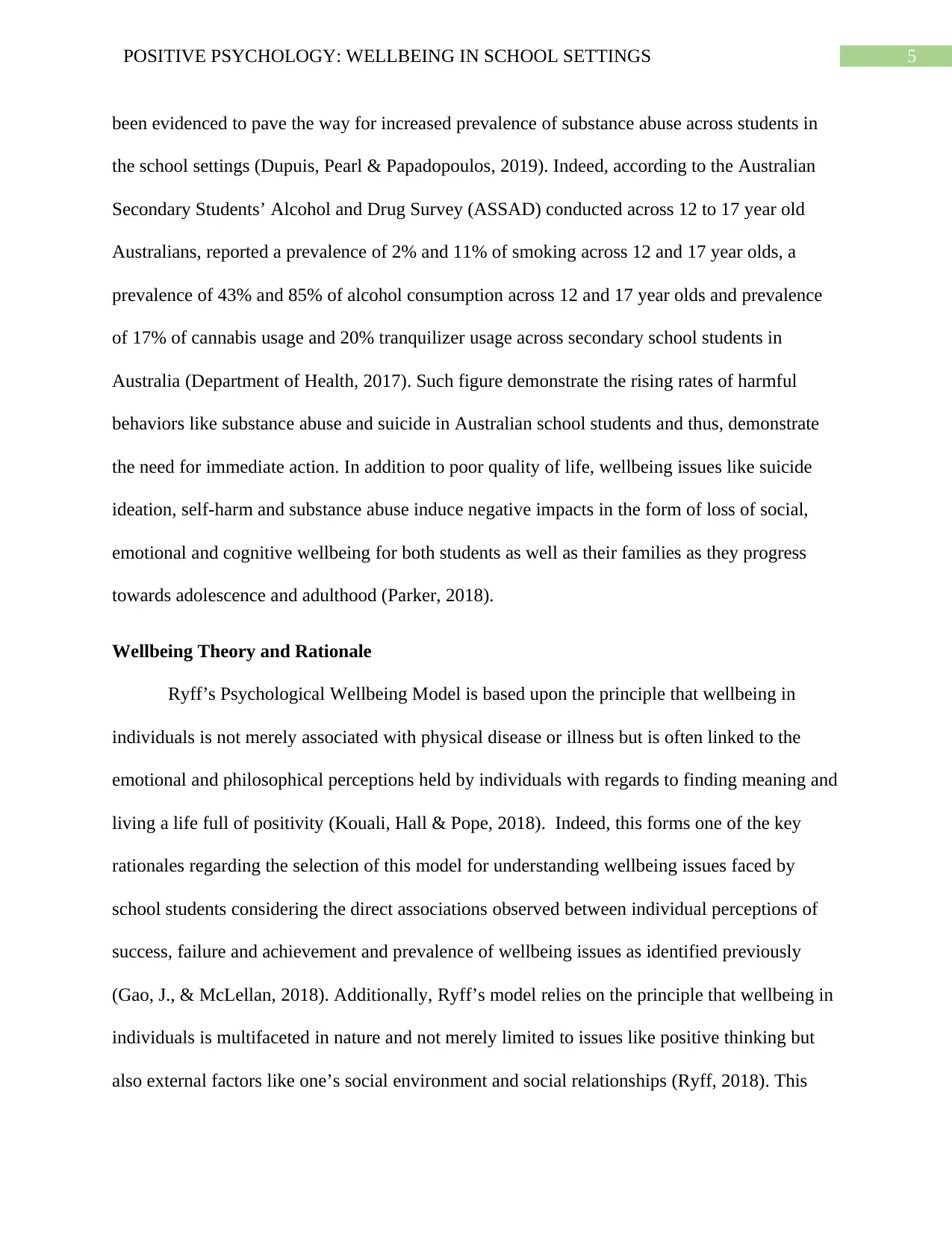
5POSITIVE PSYCHOLOGY: WELLBEING IN SCHOOL SETTINGS
been evidenced to pave the way for increased prevalence of substance abuse across students in
the school settings (Dupuis, Pearl & Papadopoulos, 2019). Indeed, according to the Australian
Secondary Students’ Alcohol and Drug Survey (ASSAD) conducted across 12 to 17 year old
Australians, reported a prevalence of 2% and 11% of smoking across 12 and 17 year olds, a
prevalence of 43% and 85% of alcohol consumption across 12 and 17 year olds and prevalence
of 17% of cannabis usage and 20% tranquilizer usage across secondary school students in
Australia (Department of Health, 2017). Such figure demonstrate the rising rates of harmful
behaviors like substance abuse and suicide in Australian school students and thus, demonstrate
the need for immediate action. In addition to poor quality of life, wellbeing issues like suicide
ideation, self-harm and substance abuse induce negative impacts in the form of loss of social,
emotional and cognitive wellbeing for both students as well as their families as they progress
towards adolescence and adulthood (Parker, 2018).
Wellbeing Theory and Rationale
Ryff’s Psychological Wellbeing Model is based upon the principle that wellbeing in
individuals is not merely associated with physical disease or illness but is often linked to the
emotional and philosophical perceptions held by individuals with regards to finding meaning and
living a life full of positivity (Kouali, Hall & Pope, 2018). Indeed, this forms one of the key
rationales regarding the selection of this model for understanding wellbeing issues faced by
school students considering the direct associations observed between individual perceptions of
success, failure and achievement and prevalence of wellbeing issues as identified previously
(Gao, J., & McLellan, 2018). Additionally, Ryff’s model relies on the principle that wellbeing in
individuals is multifaceted in nature and not merely limited to issues like positive thinking but
also external factors like one’s social environment and social relationships (Ryff, 2018). This
been evidenced to pave the way for increased prevalence of substance abuse across students in
the school settings (Dupuis, Pearl & Papadopoulos, 2019). Indeed, according to the Australian
Secondary Students’ Alcohol and Drug Survey (ASSAD) conducted across 12 to 17 year old
Australians, reported a prevalence of 2% and 11% of smoking across 12 and 17 year olds, a
prevalence of 43% and 85% of alcohol consumption across 12 and 17 year olds and prevalence
of 17% of cannabis usage and 20% tranquilizer usage across secondary school students in
Australia (Department of Health, 2017). Such figure demonstrate the rising rates of harmful
behaviors like substance abuse and suicide in Australian school students and thus, demonstrate
the need for immediate action. In addition to poor quality of life, wellbeing issues like suicide
ideation, self-harm and substance abuse induce negative impacts in the form of loss of social,
emotional and cognitive wellbeing for both students as well as their families as they progress
towards adolescence and adulthood (Parker, 2018).
Wellbeing Theory and Rationale
Ryff’s Psychological Wellbeing Model is based upon the principle that wellbeing in
individuals is not merely associated with physical disease or illness but is often linked to the
emotional and philosophical perceptions held by individuals with regards to finding meaning and
living a life full of positivity (Kouali, Hall & Pope, 2018). Indeed, this forms one of the key
rationales regarding the selection of this model for understanding wellbeing issues faced by
school students considering the direct associations observed between individual perceptions of
success, failure and achievement and prevalence of wellbeing issues as identified previously
(Gao, J., & McLellan, 2018). Additionally, Ryff’s model relies on the principle that wellbeing in
individuals is multifaceted in nature and not merely limited to issues like positive thinking but
also external factors like one’s social environment and social relationships (Ryff, 2018). This
⊘ This is a preview!⊘
Do you want full access?
Subscribe today to unlock all pages.

Trusted by 1+ million students worldwide
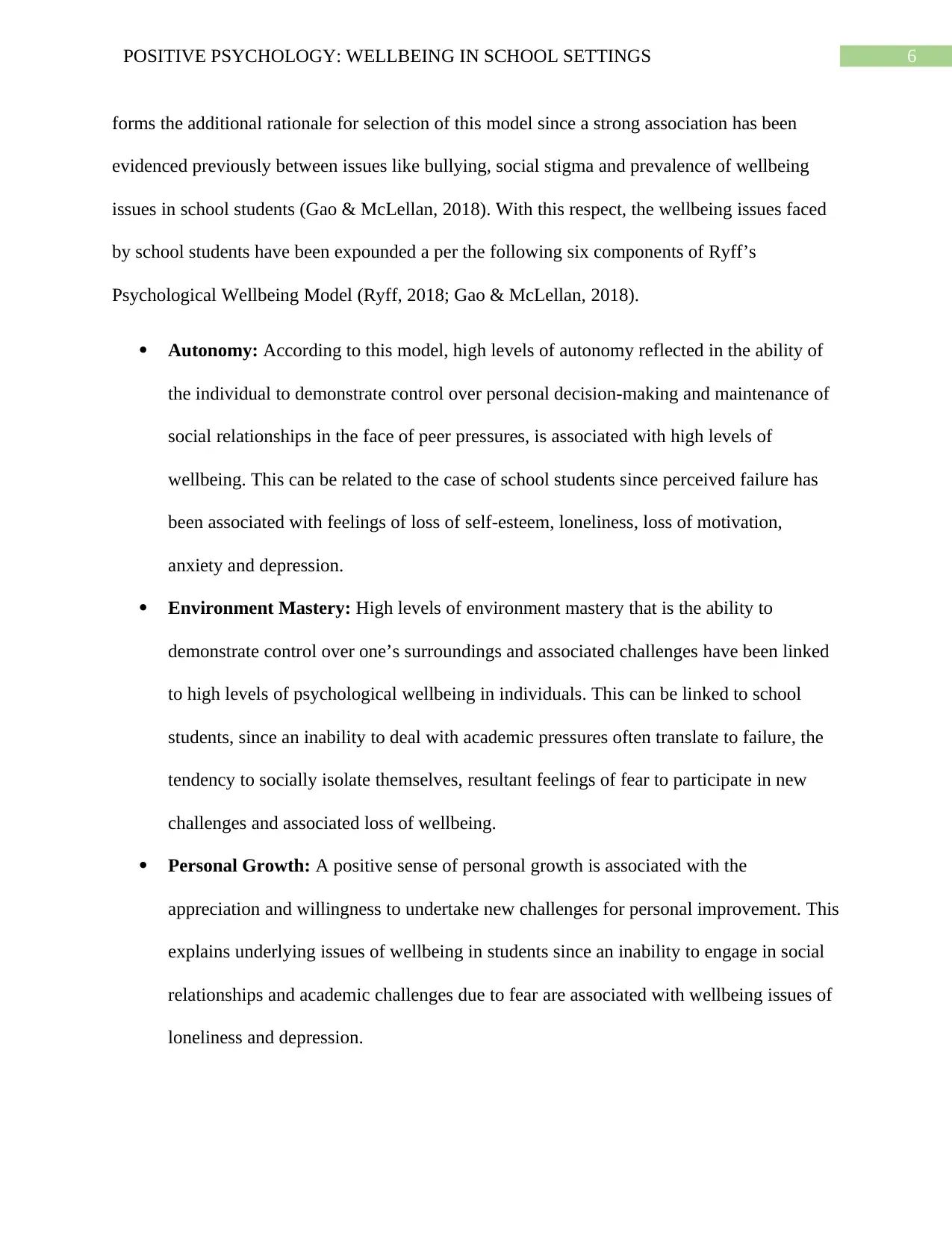
6POSITIVE PSYCHOLOGY: WELLBEING IN SCHOOL SETTINGS
forms the additional rationale for selection of this model since a strong association has been
evidenced previously between issues like bullying, social stigma and prevalence of wellbeing
issues in school students (Gao & McLellan, 2018). With this respect, the wellbeing issues faced
by school students have been expounded a per the following six components of Ryff’s
Psychological Wellbeing Model (Ryff, 2018; Gao & McLellan, 2018).
Autonomy: According to this model, high levels of autonomy reflected in the ability of
the individual to demonstrate control over personal decision-making and maintenance of
social relationships in the face of peer pressures, is associated with high levels of
wellbeing. This can be related to the case of school students since perceived failure has
been associated with feelings of loss of self-esteem, loneliness, loss of motivation,
anxiety and depression.
Environment Mastery: High levels of environment mastery that is the ability to
demonstrate control over one’s surroundings and associated challenges have been linked
to high levels of psychological wellbeing in individuals. This can be linked to school
students, since an inability to deal with academic pressures often translate to failure, the
tendency to socially isolate themselves, resultant feelings of fear to participate in new
challenges and associated loss of wellbeing.
Personal Growth: A positive sense of personal growth is associated with the
appreciation and willingness to undertake new challenges for personal improvement. This
explains underlying issues of wellbeing in students since an inability to engage in social
relationships and academic challenges due to fear are associated with wellbeing issues of
loneliness and depression.
forms the additional rationale for selection of this model since a strong association has been
evidenced previously between issues like bullying, social stigma and prevalence of wellbeing
issues in school students (Gao & McLellan, 2018). With this respect, the wellbeing issues faced
by school students have been expounded a per the following six components of Ryff’s
Psychological Wellbeing Model (Ryff, 2018; Gao & McLellan, 2018).
Autonomy: According to this model, high levels of autonomy reflected in the ability of
the individual to demonstrate control over personal decision-making and maintenance of
social relationships in the face of peer pressures, is associated with high levels of
wellbeing. This can be related to the case of school students since perceived failure has
been associated with feelings of loss of self-esteem, loneliness, loss of motivation,
anxiety and depression.
Environment Mastery: High levels of environment mastery that is the ability to
demonstrate control over one’s surroundings and associated challenges have been linked
to high levels of psychological wellbeing in individuals. This can be linked to school
students, since an inability to deal with academic pressures often translate to failure, the
tendency to socially isolate themselves, resultant feelings of fear to participate in new
challenges and associated loss of wellbeing.
Personal Growth: A positive sense of personal growth is associated with the
appreciation and willingness to undertake new challenges for personal improvement. This
explains underlying issues of wellbeing in students since an inability to engage in social
relationships and academic challenges due to fear are associated with wellbeing issues of
loneliness and depression.
Paraphrase This Document
Need a fresh take? Get an instant paraphrase of this document with our AI Paraphraser
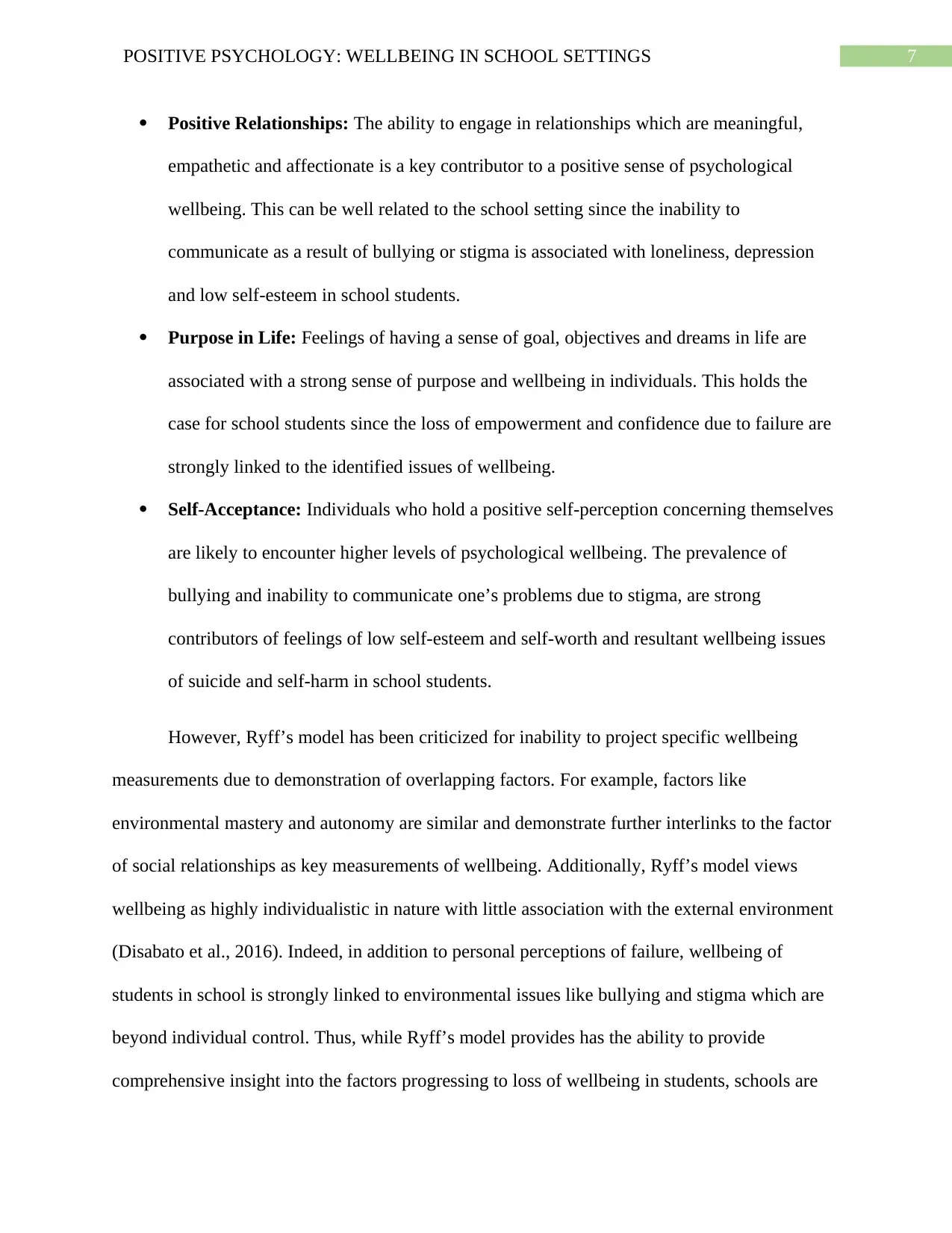
7POSITIVE PSYCHOLOGY: WELLBEING IN SCHOOL SETTINGS
Positive Relationships: The ability to engage in relationships which are meaningful,
empathetic and affectionate is a key contributor to a positive sense of psychological
wellbeing. This can be well related to the school setting since the inability to
communicate as a result of bullying or stigma is associated with loneliness, depression
and low self-esteem in school students.
Purpose in Life: Feelings of having a sense of goal, objectives and dreams in life are
associated with a strong sense of purpose and wellbeing in individuals. This holds the
case for school students since the loss of empowerment and confidence due to failure are
strongly linked to the identified issues of wellbeing.
Self-Acceptance: Individuals who hold a positive self-perception concerning themselves
are likely to encounter higher levels of psychological wellbeing. The prevalence of
bullying and inability to communicate one’s problems due to stigma, are strong
contributors of feelings of low self-esteem and self-worth and resultant wellbeing issues
of suicide and self-harm in school students.
However, Ryff’s model has been criticized for inability to project specific wellbeing
measurements due to demonstration of overlapping factors. For example, factors like
environmental mastery and autonomy are similar and demonstrate further interlinks to the factor
of social relationships as key measurements of wellbeing. Additionally, Ryff’s model views
wellbeing as highly individualistic in nature with little association with the external environment
(Disabato et al., 2016). Indeed, in addition to personal perceptions of failure, wellbeing of
students in school is strongly linked to environmental issues like bullying and stigma which are
beyond individual control. Thus, while Ryff’s model provides has the ability to provide
comprehensive insight into the factors progressing to loss of wellbeing in students, schools are
Positive Relationships: The ability to engage in relationships which are meaningful,
empathetic and affectionate is a key contributor to a positive sense of psychological
wellbeing. This can be well related to the school setting since the inability to
communicate as a result of bullying or stigma is associated with loneliness, depression
and low self-esteem in school students.
Purpose in Life: Feelings of having a sense of goal, objectives and dreams in life are
associated with a strong sense of purpose and wellbeing in individuals. This holds the
case for school students since the loss of empowerment and confidence due to failure are
strongly linked to the identified issues of wellbeing.
Self-Acceptance: Individuals who hold a positive self-perception concerning themselves
are likely to encounter higher levels of psychological wellbeing. The prevalence of
bullying and inability to communicate one’s problems due to stigma, are strong
contributors of feelings of low self-esteem and self-worth and resultant wellbeing issues
of suicide and self-harm in school students.
However, Ryff’s model has been criticized for inability to project specific wellbeing
measurements due to demonstration of overlapping factors. For example, factors like
environmental mastery and autonomy are similar and demonstrate further interlinks to the factor
of social relationships as key measurements of wellbeing. Additionally, Ryff’s model views
wellbeing as highly individualistic in nature with little association with the external environment
(Disabato et al., 2016). Indeed, in addition to personal perceptions of failure, wellbeing of
students in school is strongly linked to environmental issues like bullying and stigma which are
beyond individual control. Thus, while Ryff’s model provides has the ability to provide
comprehensive insight into the factors progressing to loss of wellbeing in students, schools are
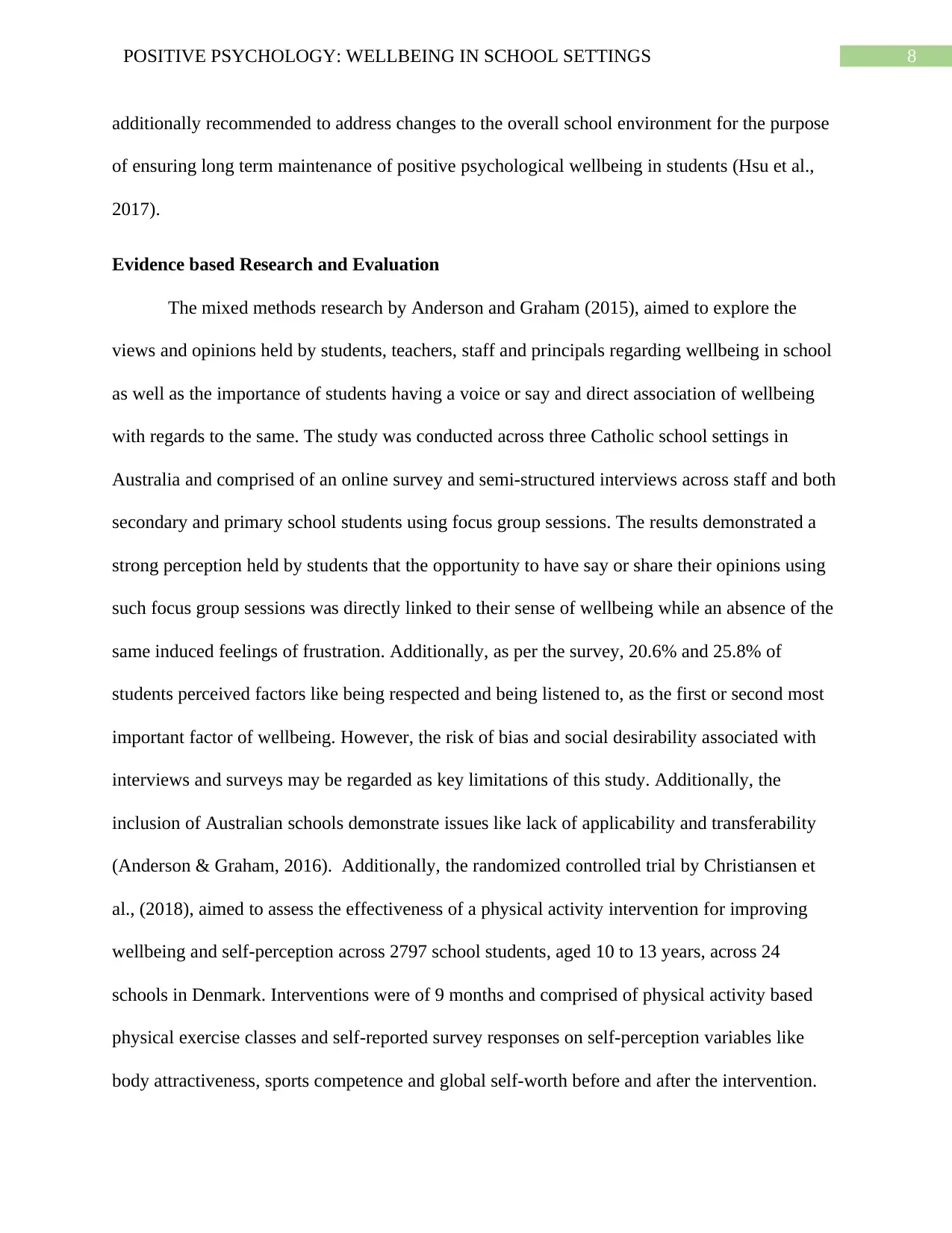
8POSITIVE PSYCHOLOGY: WELLBEING IN SCHOOL SETTINGS
additionally recommended to address changes to the overall school environment for the purpose
of ensuring long term maintenance of positive psychological wellbeing in students (Hsu et al.,
2017).
Evidence based Research and Evaluation
The mixed methods research by Anderson and Graham (2015), aimed to explore the
views and opinions held by students, teachers, staff and principals regarding wellbeing in school
as well as the importance of students having a voice or say and direct association of wellbeing
with regards to the same. The study was conducted across three Catholic school settings in
Australia and comprised of an online survey and semi-structured interviews across staff and both
secondary and primary school students using focus group sessions. The results demonstrated a
strong perception held by students that the opportunity to have say or share their opinions using
such focus group sessions was directly linked to their sense of wellbeing while an absence of the
same induced feelings of frustration. Additionally, as per the survey, 20.6% and 25.8% of
students perceived factors like being respected and being listened to, as the first or second most
important factor of wellbeing. However, the risk of bias and social desirability associated with
interviews and surveys may be regarded as key limitations of this study. Additionally, the
inclusion of Australian schools demonstrate issues like lack of applicability and transferability
(Anderson & Graham, 2016). Additionally, the randomized controlled trial by Christiansen et
al., (2018), aimed to assess the effectiveness of a physical activity intervention for improving
wellbeing and self-perception across 2797 school students, aged 10 to 13 years, across 24
schools in Denmark. Interventions were of 9 months and comprised of physical activity based
physical exercise classes and self-reported survey responses on self-perception variables like
body attractiveness, sports competence and global self-worth before and after the intervention.
additionally recommended to address changes to the overall school environment for the purpose
of ensuring long term maintenance of positive psychological wellbeing in students (Hsu et al.,
2017).
Evidence based Research and Evaluation
The mixed methods research by Anderson and Graham (2015), aimed to explore the
views and opinions held by students, teachers, staff and principals regarding wellbeing in school
as well as the importance of students having a voice or say and direct association of wellbeing
with regards to the same. The study was conducted across three Catholic school settings in
Australia and comprised of an online survey and semi-structured interviews across staff and both
secondary and primary school students using focus group sessions. The results demonstrated a
strong perception held by students that the opportunity to have say or share their opinions using
such focus group sessions was directly linked to their sense of wellbeing while an absence of the
same induced feelings of frustration. Additionally, as per the survey, 20.6% and 25.8% of
students perceived factors like being respected and being listened to, as the first or second most
important factor of wellbeing. However, the risk of bias and social desirability associated with
interviews and surveys may be regarded as key limitations of this study. Additionally, the
inclusion of Australian schools demonstrate issues like lack of applicability and transferability
(Anderson & Graham, 2016). Additionally, the randomized controlled trial by Christiansen et
al., (2018), aimed to assess the effectiveness of a physical activity intervention for improving
wellbeing and self-perception across 2797 school students, aged 10 to 13 years, across 24
schools in Denmark. Interventions were of 9 months and comprised of physical activity based
physical exercise classes and self-reported survey responses on self-perception variables like
body attractiveness, sports competence and global self-worth before and after the intervention.
⊘ This is a preview!⊘
Do you want full access?
Subscribe today to unlock all pages.

Trusted by 1+ million students worldwide
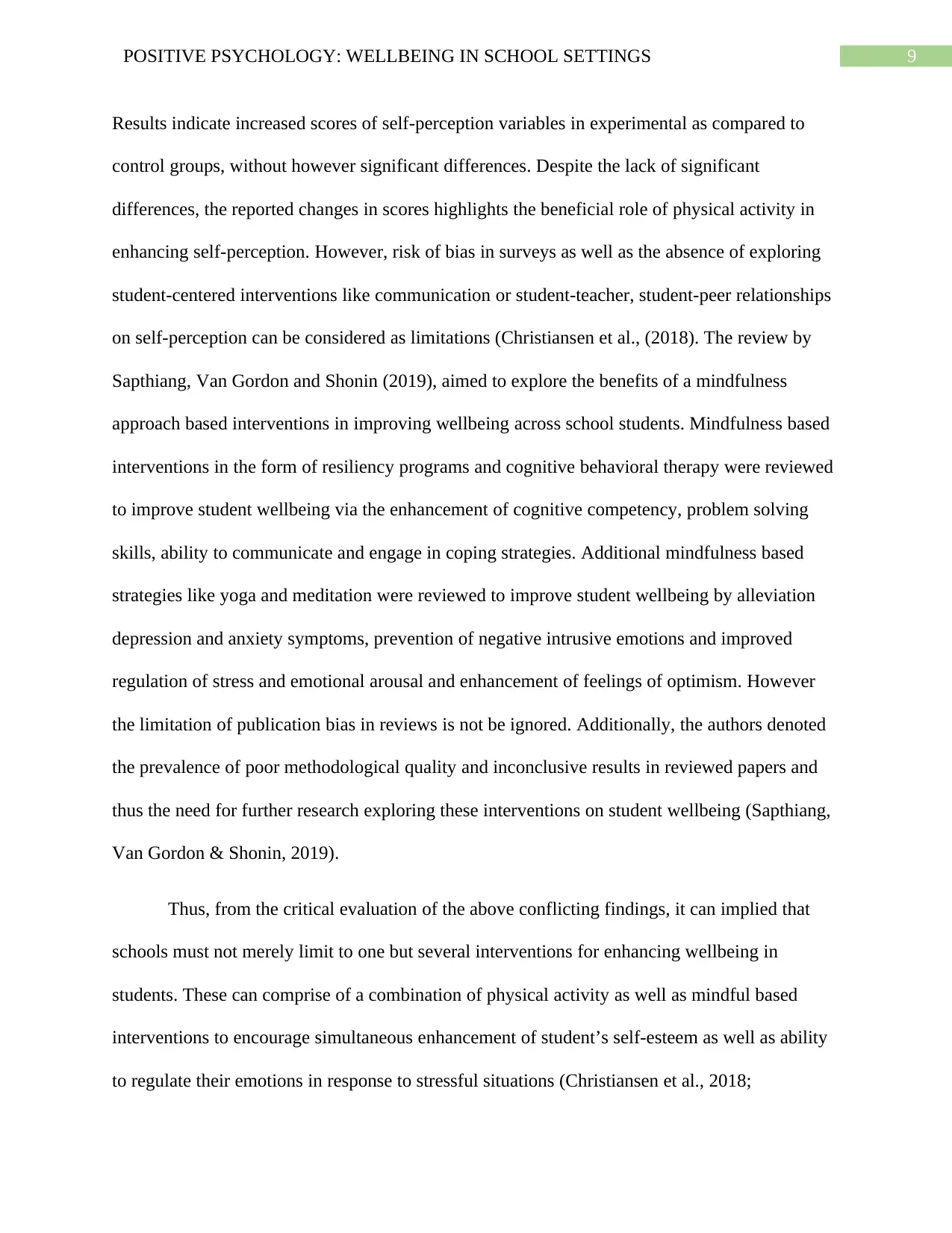
9POSITIVE PSYCHOLOGY: WELLBEING IN SCHOOL SETTINGS
Results indicate increased scores of self-perception variables in experimental as compared to
control groups, without however significant differences. Despite the lack of significant
differences, the reported changes in scores highlights the beneficial role of physical activity in
enhancing self-perception. However, risk of bias in surveys as well as the absence of exploring
student-centered interventions like communication or student-teacher, student-peer relationships
on self-perception can be considered as limitations (Christiansen et al., (2018). The review by
Sapthiang, Van Gordon and Shonin (2019), aimed to explore the benefits of a mindfulness
approach based interventions in improving wellbeing across school students. Mindfulness based
interventions in the form of resiliency programs and cognitive behavioral therapy were reviewed
to improve student wellbeing via the enhancement of cognitive competency, problem solving
skills, ability to communicate and engage in coping strategies. Additional mindfulness based
strategies like yoga and meditation were reviewed to improve student wellbeing by alleviation
depression and anxiety symptoms, prevention of negative intrusive emotions and improved
regulation of stress and emotional arousal and enhancement of feelings of optimism. However
the limitation of publication bias in reviews is not be ignored. Additionally, the authors denoted
the prevalence of poor methodological quality and inconclusive results in reviewed papers and
thus the need for further research exploring these interventions on student wellbeing (Sapthiang,
Van Gordon & Shonin, 2019).
Thus, from the critical evaluation of the above conflicting findings, it can implied that
schools must not merely limit to one but several interventions for enhancing wellbeing in
students. These can comprise of a combination of physical activity as well as mindful based
interventions to encourage simultaneous enhancement of student’s self-esteem as well as ability
to regulate their emotions in response to stressful situations (Christiansen et al., 2018;
Results indicate increased scores of self-perception variables in experimental as compared to
control groups, without however significant differences. Despite the lack of significant
differences, the reported changes in scores highlights the beneficial role of physical activity in
enhancing self-perception. However, risk of bias in surveys as well as the absence of exploring
student-centered interventions like communication or student-teacher, student-peer relationships
on self-perception can be considered as limitations (Christiansen et al., (2018). The review by
Sapthiang, Van Gordon and Shonin (2019), aimed to explore the benefits of a mindfulness
approach based interventions in improving wellbeing across school students. Mindfulness based
interventions in the form of resiliency programs and cognitive behavioral therapy were reviewed
to improve student wellbeing via the enhancement of cognitive competency, problem solving
skills, ability to communicate and engage in coping strategies. Additional mindfulness based
strategies like yoga and meditation were reviewed to improve student wellbeing by alleviation
depression and anxiety symptoms, prevention of negative intrusive emotions and improved
regulation of stress and emotional arousal and enhancement of feelings of optimism. However
the limitation of publication bias in reviews is not be ignored. Additionally, the authors denoted
the prevalence of poor methodological quality and inconclusive results in reviewed papers and
thus the need for further research exploring these interventions on student wellbeing (Sapthiang,
Van Gordon & Shonin, 2019).
Thus, from the critical evaluation of the above conflicting findings, it can implied that
schools must not merely limit to one but several interventions for enhancing wellbeing in
students. These can comprise of a combination of physical activity as well as mindful based
interventions to encourage simultaneous enhancement of student’s self-esteem as well as ability
to regulate their emotions in response to stressful situations (Christiansen et al., 2018;
Paraphrase This Document
Need a fresh take? Get an instant paraphrase of this document with our AI Paraphraser
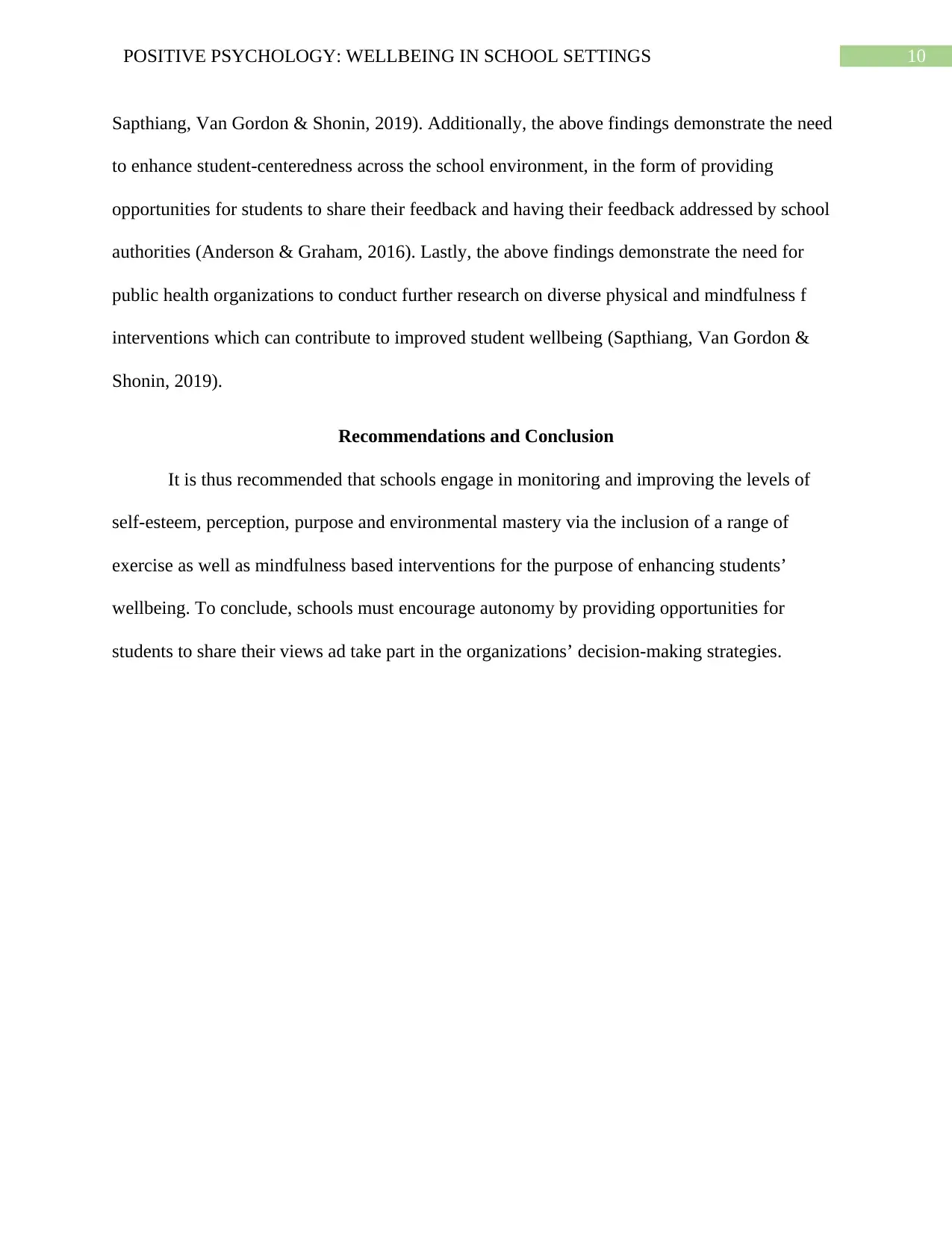
10POSITIVE PSYCHOLOGY: WELLBEING IN SCHOOL SETTINGS
Sapthiang, Van Gordon & Shonin, 2019). Additionally, the above findings demonstrate the need
to enhance student-centeredness across the school environment, in the form of providing
opportunities for students to share their feedback and having their feedback addressed by school
authorities (Anderson & Graham, 2016). Lastly, the above findings demonstrate the need for
public health organizations to conduct further research on diverse physical and mindfulness f
interventions which can contribute to improved student wellbeing (Sapthiang, Van Gordon &
Shonin, 2019).
Recommendations and Conclusion
It is thus recommended that schools engage in monitoring and improving the levels of
self-esteem, perception, purpose and environmental mastery via the inclusion of a range of
exercise as well as mindfulness based interventions for the purpose of enhancing students’
wellbeing. To conclude, schools must encourage autonomy by providing opportunities for
students to share their views ad take part in the organizations’ decision-making strategies.
Sapthiang, Van Gordon & Shonin, 2019). Additionally, the above findings demonstrate the need
to enhance student-centeredness across the school environment, in the form of providing
opportunities for students to share their feedback and having their feedback addressed by school
authorities (Anderson & Graham, 2016). Lastly, the above findings demonstrate the need for
public health organizations to conduct further research on diverse physical and mindfulness f
interventions which can contribute to improved student wellbeing (Sapthiang, Van Gordon &
Shonin, 2019).
Recommendations and Conclusion
It is thus recommended that schools engage in monitoring and improving the levels of
self-esteem, perception, purpose and environmental mastery via the inclusion of a range of
exercise as well as mindfulness based interventions for the purpose of enhancing students’
wellbeing. To conclude, schools must encourage autonomy by providing opportunities for
students to share their views ad take part in the organizations’ decision-making strategies.
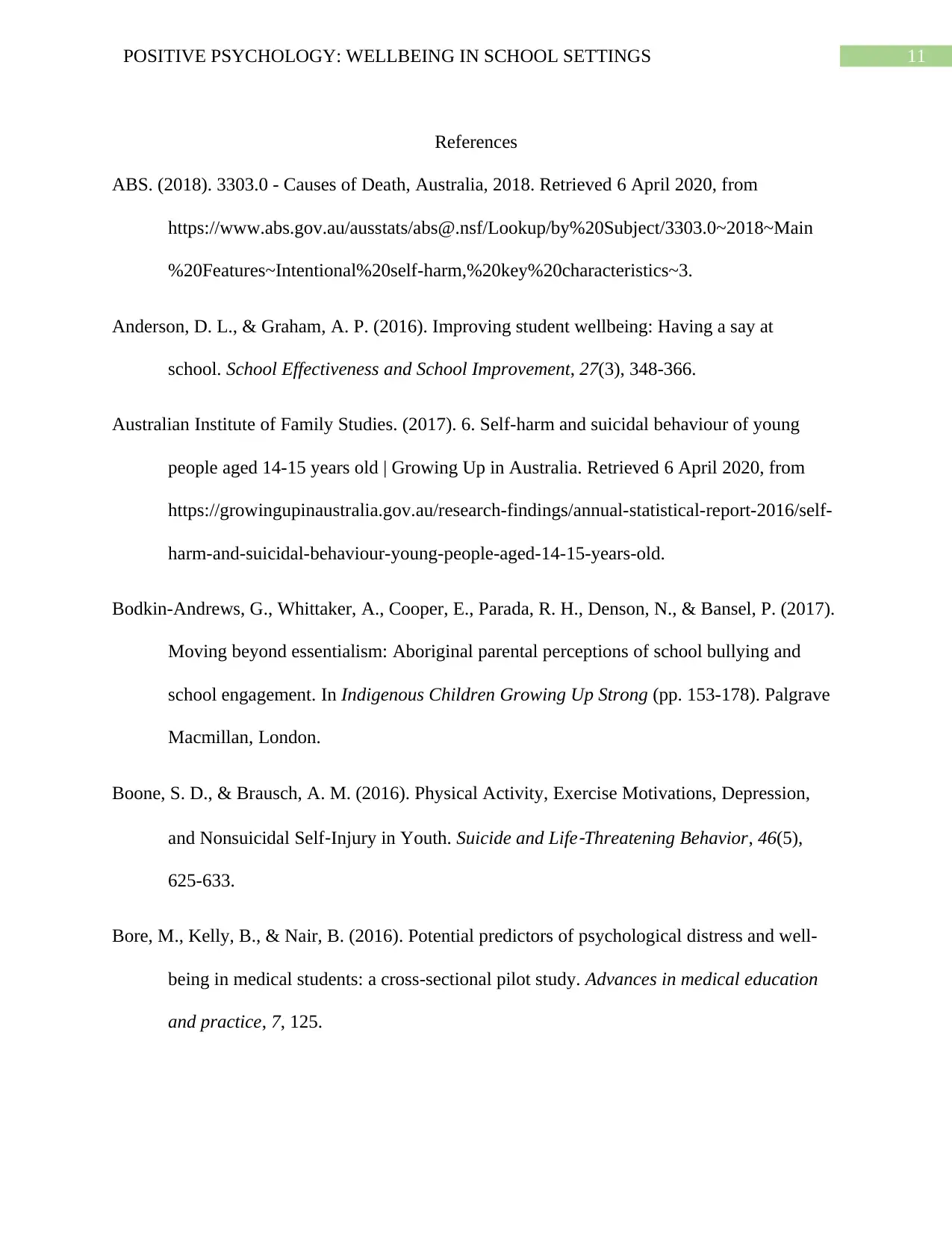
11POSITIVE PSYCHOLOGY: WELLBEING IN SCHOOL SETTINGS
References
ABS. (2018). 3303.0 - Causes of Death, Australia, 2018. Retrieved 6 April 2020, from
https://www.abs.gov.au/ausstats/abs@.nsf/Lookup/by%20Subject/3303.0~2018~Main
%20Features~Intentional%20self-harm,%20key%20characteristics~3.
Anderson, D. L., & Graham, A. P. (2016). Improving student wellbeing: Having a say at
school. School Effectiveness and School Improvement, 27(3), 348-366.
Australian Institute of Family Studies. (2017). 6. Self-harm and suicidal behaviour of young
people aged 14-15 years old | Growing Up in Australia. Retrieved 6 April 2020, from
https://growingupinaustralia.gov.au/research-findings/annual-statistical-report-2016/self-
harm-and-suicidal-behaviour-young-people-aged-14-15-years-old.
Bodkin-Andrews, G., Whittaker, A., Cooper, E., Parada, R. H., Denson, N., & Bansel, P. (2017).
Moving beyond essentialism: Aboriginal parental perceptions of school bullying and
school engagement. In Indigenous Children Growing Up Strong (pp. 153-178). Palgrave
Macmillan, London.
Boone, S. D., & Brausch, A. M. (2016). Physical Activity, Exercise Motivations, Depression,
and Nonsuicidal Self‐Injury in Youth. Suicide and Life
‐Threatening Behavior, 46(5),
625-633.
Bore, M., Kelly, B., & Nair, B. (2016). Potential predictors of psychological distress and well-
being in medical students: a cross-sectional pilot study. Advances in medical education
and practice, 7, 125.
References
ABS. (2018). 3303.0 - Causes of Death, Australia, 2018. Retrieved 6 April 2020, from
https://www.abs.gov.au/ausstats/abs@.nsf/Lookup/by%20Subject/3303.0~2018~Main
%20Features~Intentional%20self-harm,%20key%20characteristics~3.
Anderson, D. L., & Graham, A. P. (2016). Improving student wellbeing: Having a say at
school. School Effectiveness and School Improvement, 27(3), 348-366.
Australian Institute of Family Studies. (2017). 6. Self-harm and suicidal behaviour of young
people aged 14-15 years old | Growing Up in Australia. Retrieved 6 April 2020, from
https://growingupinaustralia.gov.au/research-findings/annual-statistical-report-2016/self-
harm-and-suicidal-behaviour-young-people-aged-14-15-years-old.
Bodkin-Andrews, G., Whittaker, A., Cooper, E., Parada, R. H., Denson, N., & Bansel, P. (2017).
Moving beyond essentialism: Aboriginal parental perceptions of school bullying and
school engagement. In Indigenous Children Growing Up Strong (pp. 153-178). Palgrave
Macmillan, London.
Boone, S. D., & Brausch, A. M. (2016). Physical Activity, Exercise Motivations, Depression,
and Nonsuicidal Self‐Injury in Youth. Suicide and Life
‐Threatening Behavior, 46(5),
625-633.
Bore, M., Kelly, B., & Nair, B. (2016). Potential predictors of psychological distress and well-
being in medical students: a cross-sectional pilot study. Advances in medical education
and practice, 7, 125.
⊘ This is a preview!⊘
Do you want full access?
Subscribe today to unlock all pages.

Trusted by 1+ million students worldwide
1 out of 16
Related Documents
Your All-in-One AI-Powered Toolkit for Academic Success.
+13062052269
info@desklib.com
Available 24*7 on WhatsApp / Email
![[object Object]](/_next/static/media/star-bottom.7253800d.svg)
Unlock your academic potential
Copyright © 2020–2025 A2Z Services. All Rights Reserved. Developed and managed by ZUCOL.





